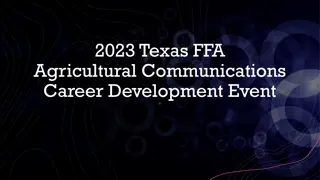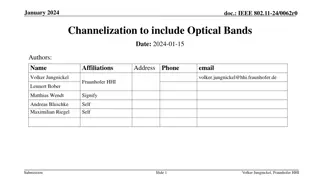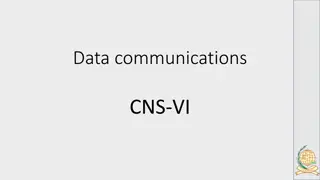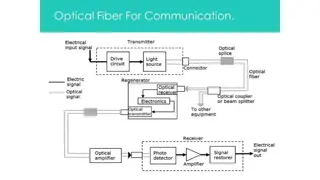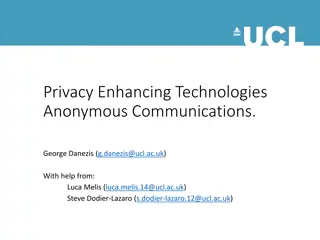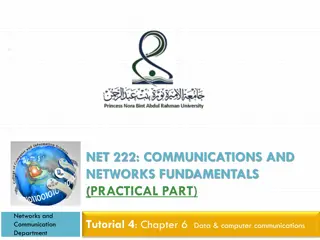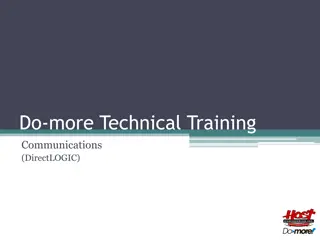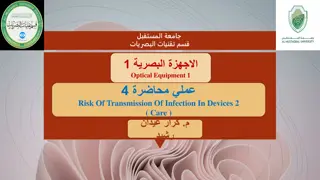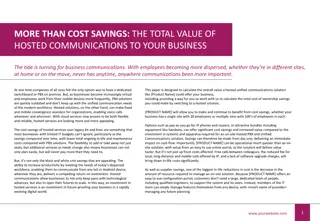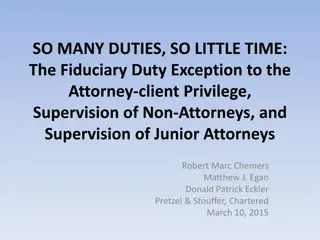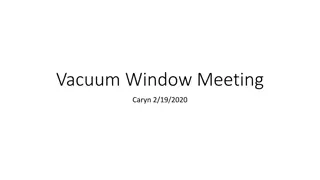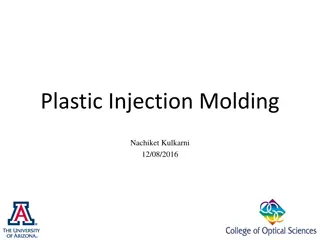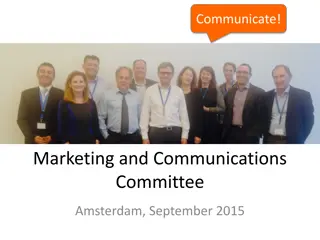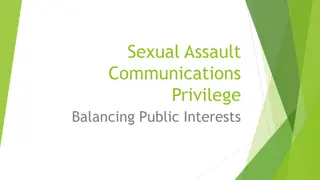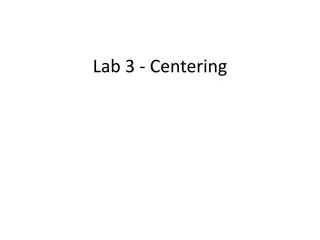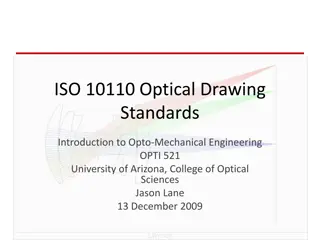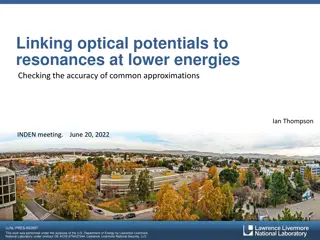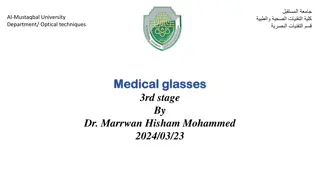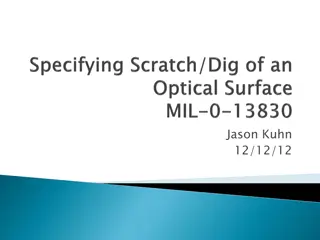Satellite Communications Support for Enhanced Emergency Communications
Providing support for enhanced emergency communications through mobile and fly-away satellite systems. These systems offer cellular-based WiFi, satellite-based WiFi, and voice over IP phone numbers for use during communication disruptions. Satellite airtime is provided at no cost to TxDOT through th
2 views • 4 slides
Texas FFA Agricultural Communications Career Development Event 2023
The 2023 Texas FFA Agricultural Communications Career Development Event offers a comprehensive schedule including team orientation, press conference, quizzes, practicums, and more. Contestants will engage in activities such as a communications quiz, editing exercise, practicum work, and web design.
1 views • 20 slides
CEPT Workshop on 6G Mobile Communications: Numbering & Network Issues
CEPT Workshop on 6G Mobile Communications, led by Elizabeth Greenberg of Ofcom UK, addresses the role of numbering and networks in the ECC, numbering considerations for 6G, and how WG NaN contributes to the development of numbering for 6G technologies. Key topics include ensuring non-discriminatory
1 views • 8 slides
Expert Group on Communications Technology for Automated Driving
The Expert Group on Communications Technology for Automated Driving, established by ITU, focuses on key topics such as V2V communications capabilities, protecting vulnerable road users, and matching service life of communications equipment with automobiles. The group recently had its first meeting t
0 views • 7 slides
Channelization to Include Optical Bands in IEEE 802.11 Standards
This document discusses the proposal to incorporate optical bands into the channelization framework of the IEEE 802.11 standard. It aims to align the channelization approach for integrated LC with that of mm-wave technology in the IMMW scope. The contribution highlights recent works, emphasizing the
2 views • 11 slides
Fundamentals of Data Communications: Characteristics and Components
Data communications involve the exchange of data between devices through transmission mediums. The effectiveness of a data communications system relies on key characteristics like delivery, accuracy, timeliness, and jitter. The system components include the message, sender, receiver, transmission me
0 views • 63 slides
Optical Properties of Optically Active Compounds
Circular dichroism and optical rotatory dispersion are important techniques for studying the optical properties of optically active compounds. Circular dichroism measures the differential absorption of left and right circularly polarized light components, while optical rotatory dispersion studies th
0 views • 17 slides
Understanding Optical Telescope Types and Lens-Maker's Formula
Optical telescopes utilize lenses or mirrors to collect and focus light for imaging celestial objects. The lens-maker's formula is crucial for determining the focal length of lenses, considering factors like index of refraction and radii of curvature. Different lens configurations and materials help
0 views • 17 slides
Overview of Optical Fibre Technology and Applications
Optical fibre technology, spearheaded by Dr. Prabodh Sahai Saxena, revolutionizes communication systems through light transmission. This cutting-edge technology utilizes fibre optics made of glass or plastic to carry light signals, offering advantages like high bandwidth, low signal loss, and no ele
0 views • 20 slides
Evolution of Optical Technology: From Telegraph to Photonic Integrated Circuits
The journey of optical technology evolution spans from the invention of the telegraph in 1836, through the introduction of optical fibers in 1978, to the development of photonic integrated circuits in the present era. Key milestones include the advent of optical amplifiers in 1990, the emergence of
0 views • 70 slides
Fiber Optic Communication System Overview
This article presents a detailed explanation of a point-to-point fiber optic communication system, outlining the process from voice conversion to signal transmission and reception. It discusses the advantages and limitations of optical communication systems, along with numerical examples related to
5 views • 11 slides
Optical Equipment Safety Review and Hazard Analysis
This document provides an in-depth review of the safety considerations for the ATST optical equipment, focusing on potential hazards associated with the M2 Mirror, Heat Stop Assembly, and other critical components. The Preliminary Hazard Analysis identifies various risks, causes, and recommended act
0 views • 13 slides
Overview of Laser Delivery Systems for Surgical Procedures
Institute of Laser for Postgraduate Studies at the University of Baghdad, led by Assist. Prof. Dr. Lutfi Ghulam Awazli, focuses on laser delivery systems in surgical procedures. The systems discussed include optical fibers, articulated arms, hollow waveguides, and free beams. Optical fibers, compose
0 views • 10 slides
Understanding Optical Storage Technology
Optical storage technology originally designed for audio offers a capacity of 650MB, providing over 70 minutes of audio playback. Data is recorded digitally on a polycarbonate disk's surface as microscopic pits. The disk is organized in a spiral track with sectors of the same length arranged in bloc
5 views • 16 slides
Advances in Optical Bench Technology for Gravitational Wave Detectors
This content discusses the latest advancements in optical bench technology for gravitational wave detectors, focusing on precise measurements of back-scattered light, development of new optical cavities, and testing of Sagnac interferometers. Key objectives include improving suspension controls, red
0 views • 13 slides
Optical Alignment Using Beam Triangle Opti 521 Phil Scott
This presentation delves into the intricate process of optical alignment using a beam triangle, focusing on defining optical and mechanical axes, addressing alignment challenges, degrees of freedom for various elements, and the importance of setting up a beam triangle for accurate alignment. The con
0 views • 14 slides
Transimpedance Amplifiers in CMOS Technology for Optical Communications at 40 Gb/s
This research by Joseph Chong at Virginia Tech delves into the use of transimpedance amplifiers (TIAs) in CMOS technology for optical communications operating at a data rate of 40 Gb/s. The study outlines the motivation behind the project, the role of TIAs in optical receivers, TIA circuit topologie
0 views • 52 slides
Enhancing Privacy and Anonymous Communications with Technology
Explore the world of Privacy Enhancing Technologies (PETs) and Anonymous Communications through the work of George Danezis and his team at UCL. Dive into the challenges of network identity, lack of privacy, and weak identifiers in today's digital landscape. Learn about Ethernet and IP packet formats
0 views • 49 slides
Fundamentals of Data and Computer Communications Explained
In this tutorial, we delve into Chapter 6 of data and computer communications, focusing on transmission overhead calculations, asynchronous and synchronous communication comparisons, CRC computation, and character transmission requirements. Learn about start bits, stop bits, control bits, parity bit
1 views • 12 slides
DirectLOGIC Communications Training Overview
Explore the technical training communications for Do-more DirectLOGIC systems, focusing on setting up communication between DL Servers and Clients using built-in Ethernet ports and ECOM100 modules. Learn about communication configurations, memory allocation, and parameter settings to establish effec
0 views • 28 slides
Proper Care and Maintenance of Optical Equipment to Prevent Infections
Regular examination and proper cleaning of tonometer prisms are essential to reduce the risk of transmitting infections during eye examinations. Disinfection and sterilization processes are crucial in maintaining optical equipment hygiene. Different disinfectants and physical methods can be used to
0 views • 24 slides
Optical Frequency Interferometer Bench Analysis
Detailed examination of the optical setup for an Optical Frequency Interferometer (OFI) system, including the input/output configurations with various optical components such as prisms, crystals, and wave plates. The analysis focuses on the path and behavior of beams within the system, considering r
0 views • 14 slides
COVID-19 Outbreak Communications Toolkit for Congregate Living Environments
This communications toolkit, developed in collaboration with multiple health organizations, provides guidance and resources for managing communication during a COVID-19 outbreak in congregate living environments. It includes information on processes, notifications, web updates, media relations, key
0 views • 34 slides
Evolution of Optical Fiber Technology
Optical fiber technology has a rich history starting from John Tyndall's demonstrations in 1870 to the development of flexible fiberscopes by Hopkins and Kapany. This technology revolutionized communication systems and medical diagnostics, enabling the transmission of information through thin glass
0 views • 85 slides
Unlocking Total Value with Hosted Communications for Your Business
Business communications are evolving, with hosted solutions offering more than just cost savings. They provide flexibility, productivity enhancements, and future-proofing benefits for businesses of all sizes. Switching to a hosted communications solution like [Product Name] can lead to immediate cos
0 views • 4 slides
Understanding the Fiduciary Duty Exception to Attorney-Client Privilege
Several courts have deliberated on extending attorney-client privilege to protect communications between law firms' in-house counsel seeking advice on handling potential malpractice claims. This exception, known as the fiduciary duty exception, has faced scrutiny and rejection in recent cases, safeg
0 views • 36 slides
Optical Image Formation: Principles and Conditions
Understanding the principles and conditions governing optical image formation, including the role of broad bundles of rays, wave surfaces, magnification ratios, and axially-symmetric optical systems. Explore the conditions for imaging line segments, optical path lengths, and the general criteria for
0 views • 13 slides
Optical Testing Setup Procedures for Vacuum Windows and Polarizers
Detailed procedures for optical testing setups involving vacuum windows, polarizers, rotation stages, translation stages, photodiodes, scopes, power meters, and more. The process includes preparing the initial state, rotating analyzers, monitoring transmission, and verifying the direction and magnit
0 views • 5 slides
Enhancing Alliance Strategy Implementation through Effective Communications
This internal communications session aims to establish a framework for Secretariat communications to assist Members in strengthening the Alliance. Key focuses include aligning with the 2016-2021 Alliance strategy, identifying potential gaps, and devising strategies to address them for improved colla
0 views • 6 slides
Understanding Plastic Injection Molding for Optical Components
Plastic injection molding is a cost-effective method for mass-producing optical components, offering an economical alternative to glass. This process involves designing molds, considering factors like shrinkage and surface equations, ensuring smooth mold flow, and regulating fluid flow through gates
0 views • 12 slides
Communicate! Marketing and Communications Committee Amsterdam Meeting Summary September 2015
The meeting of the Communicate! Marketing and Communications Committee in Amsterdam focused on various themes such as clean air, public communications, public acceptance, gas innovation, and marketing campaigns. Members discussed cooperation with the IGU Presidency to support clean air campaigns, ra
0 views • 12 slides
Optical Fiber Calibration System & Adaptive Power Supply by J. Cvach
Introduction to an optical fiber calibration system and adaptive power supply developed by J. Cvach from the Institute of Physics, ASCR, Prague. The system includes an LED driver, notched fibers, and adaptive power supply for various applications, such as the calibration of the CALICE AHCAL and LHCb
0 views • 13 slides
Understanding Sexual Assault Communications Privilege and Balancing Public Interests
Exploring the complexities and practical challenges surrounding Sexual Assault Communications Privilege (SACP), this content delves into the reasons for its establishment, the services it provides, and the implications for both defence lawyers and complainants in sexual assault trials. It sheds ligh
0 views • 19 slides
Partnership Internal Communications Plan & Stakeholder Analysis
Developing an effective internal communications plan for a partnership involves drawing insights from stakeholder analysis, drafting, validating, and implementing the plan. Engaging with internal stakeholders, understanding their awareness, engagement levels, and expectations, and prioritizing commu
1 views • 6 slides
Lab 3: Centering Optical Elements & Systems with Precision
Centering optical elements and systems accurately is crucial for optical alignment processes. This lab focuses on using an air bearing rotary table and dial indicators to achieve precise centering. The equipment used includes PSM, displacement indicators, adjustment screws, and magnetic mounts. Prop
0 views • 14 slides
Understanding Nonlinear Optical Processes in Semiconductors
Exploring the complexities of nonlinear optics in the perturbative and non-perturbative regimes, this research delves into the generation of harmonics, optical Kerr effects, and extreme nonlinear optical phenomena utilizing phase-controlled electromagnetic pulses. The work also investigates the inte
0 views • 15 slides
Understanding ISO 10110 Optical Drawing Standards
ISO 10110 Optical Drawing Standards provide guidelines for preparing drawings of optical elements and systems, essential for interpreting optical drawings accurately. The standard includes 13 parts covering aspects such as material imperfections, surface form tolerances, and more. Compliance with IS
0 views • 17 slides
Exploring Optical Potentials and Resonances at Lower Energies
Investigating the accuracy of common approximations in linking optical potentials to resonances at lower energies. The study focuses on neutron reactions with 14N as a test case, transitioning from R-matrix theory to Hauser-Feshbach models and evaluating known levels and level densities. Key topics
0 views • 22 slides
Understanding Decentration in Optical Techniques for Medical Glasses
Decentration in optical lenses refers to adjusting the optical center of the lens to align directly in front of the patient's eye. This process is necessary when the frame pupillary distance (PD) or the patient's PD differs. The formula for calculating decentration in single-vision lenses is provide
0 views • 16 slides
Understanding Surface Scratch Specifications in Optical Elements
This informative content delves into the specifications for surface scratches on optical elements, highlighting criteria such as scratch width, length limitations, and scratch density requirements. It explains how to evaluate compliance with these specifications using examples and images, emphasizin
0 views • 14 slides

